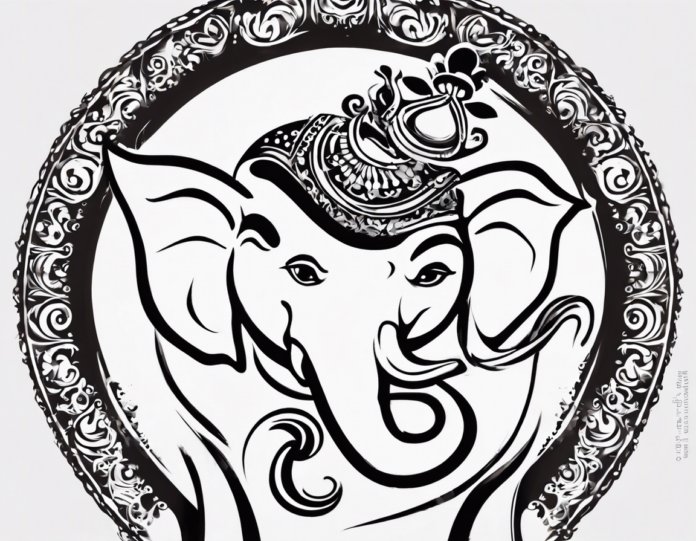Introduction
In Hindu mythology, Lord Ganesha, also known as Ganpati or Ganapati Bappa, is one of the most beloved and revered deities. He is often worshiped as the Remover of Obstacles and the god of wisdom, knowledge, and new beginnings. With his elephant head and potbelly, Ganesha’s iconography is distinctive and easily recognizable. Let’s delve deeper into the significance, symbolism, and practices associated with Ganpati Bappa in this comprehensive guide.
The Legend of Lord Ganesha
According to Hindu mythology, Ganesha is the son of Lord Shiva and Goddess Parvati. The story of his birth varies in different texts, but a popular version narrates that Parvati created Ganesha from sandalwood paste to guard her privacy while she took a bath. When Shiva returned and was denied entry by Ganesha, he beheaded him in a fit of rage. Upon realizing his mistake, Shiva granted Ganesha a new life by attaching the head of an elephant to his body. This is why Ganesha is depicted with an elephant head.
Symbolism of Ganpati Bappa
- Elephant Head: The elephant head symbolizes wisdom, intelligence, and the ability to remove obstacles.
- Large Ears: Ganesha is said to have big ears to listen more and talk less, signifying the importance of listening attentively.
- Trunk: The trunk represents adaptability, strength, and efficiency in overcoming any obstacle.
- Modak: Ganesha is often depicted holding a modak, a sweet dumpling, symbolizing the sweetness of knowledge and the rewards of a spiritual journey.
- Broken Tusk: The broken tusk Ganesha holds symbolizes sacrifice and the idea that sometimes one must let go of something to gain better things in life.
Worship and Festivals
Ganesh Chaturthi is a popular Hindu festival celebrated to honor Ganpati Bappa’s birthday. The festival usually falls in August or September, depending on the lunar calendar. During this 10-day festival, people bring idols of Ganesha into their homes or community pandals, offer prayers, perform aarti, and immerse the idols in water bodies on the final day.
Significance in Modern Times
In contemporary culture, Ganpati Bappa holds a significant place not only in religious practices but also in various aspects of life. Many people worship Ganesha before beginning a new venture or seeking blessings for success. His benevolent nature and association with wisdom and intellect have made him a popular deity among students, artists, and entrepreneurs.
How to Seek Ganpati Bappa’s Blessings
- Sincere Devotion: Approach Lord Ganesha with a pure heart and sincere devotion.
- Offerings: Offer fruits, flowers, modak, and other sweets – Ganesha’s favorite foods.
- Modak: Considered Ganesha’s favorite treat, offering modak is believed to please him.
- Chanting Mantras: Reciting Ganesh mantras such as “Om Gam Ganapataye Namaha” is said to invoke his blessings.
- Participate in Aarti: Joining aarti ceremonies dedicated to Ganesha is a way to seek his divine grace.
Popular Mantras and Chants
- “Om Gam Ganapataye Namaha”: This mantra is widely used to offer salutations to Lord Ganesha.
- “Vakratunda Mahakaya”: It is a popular prayer that seeks the removal of obstacles in one’s path.
- “Ganapati Atharvashirsha”: An ancient Sanskrit text dedicated to Lord Ganesha, praising his qualities and powers.
FAQs (Frequently Asked Questions)
-
Q: Is Ganpati Bappa worshiped only in India?
A: No, the worship of Lord Ganesha extends beyond India to various countries where Hinduism is practiced, such as Nepal, Sri Lanka, and Indonesia. -
Q: What is the significance of Ganesh Chaturthi?
A: Ganesh Chaturthi celebrates the birth of Lord Ganesha and is observed with great enthusiasm by devotees across India. -
Q: Why is Ganesha called the Remover of Obstacles?
A: Ganesha is believed to clear obstacles from the path of his devotees, making it easier for them to achieve their goals. -
Q: What are some common symbols associated with Lord Ganesha?
A: Symbols associated with Lord Ganesha include his elephant head, large ears, broken tusk, modak, and mouse as his vehicle. -
Q: How long is the Ganesh Chaturthi festival typically celebrated?
A: The Ganesh Chaturthi festival usually spans ten days, culminating in the immersion of Ganesha idols in water bodies. -
Q: Can non-Hindus worship Lord Ganesha?
A: Yes, Lord Ganesha is revered beyond religious boundaries, and people from various faiths seek his blessings for wisdom and success. -
Q: What is the significance of offering modak to Ganesha?
A: Modak is considered Ganesha’s favorite sweet, symbolizing the fulfillment of desires and the sweetness of knowledge. -
Q: Are there specific colors associated with Lord Ganesha?
A: The most common colors associated with Lord Ganesha are red, yellow, and green, symbolizing energy, auspiciousness, and harmony.
In conclusion, the worship of Ganpati Bappa transcends religious boundaries and holds immense significance in various aspects of life. As the Remover of Obstacles, Lord Ganesha guides his devotees on the path of wisdom, success, and fulfillment. By understanding the symbolism, practices, and chants associated with Ganpati Bappa, one can cultivate a deeper connection with this beloved deity.

